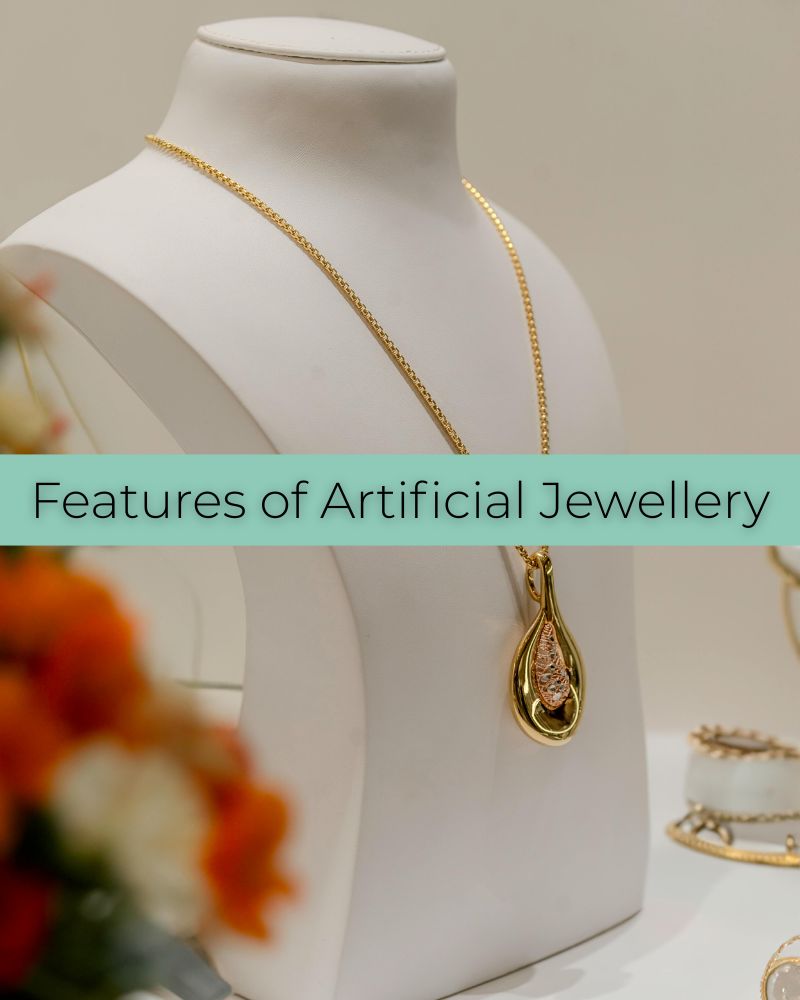Jewellery is more than just decoration it’s a reflection of personality, culture, and style.
From weddings to casual outings, the right accessory can completely transform an outfit. In today’s fashion market, you’ll often come across two popular terms: artificial jewellery and imitation jewellery.
While many people use them interchangeably, there’s a subtle yet important difference between the two.
Knowing this difference can help you make better buying decisions, avoid confusion while shopping, and choose pieces that match your needs, budget, and style.
In this blog, we’ll explore:
-
The meaning of artificial and imitation jewellery
-
How they are made
-
The differences between them
-
Which one you should choose for different occasions
-
Care tips to make them last longer
1. Understanding the Basics

What is Artificial Jewellery?
Artificial jewellery refers to ornaments made from non-precious metals and materials such as brass, copper, aluminium, alloys, beads, plastic, glass, wood, acrylic, and synthetic stones.
The focus is on design creativity, affordability, and variety rather than on the value of the raw materials.
Key Features of Artificial Jewellery:
-
Available in modern, ethnic, bohemian, and minimalist styles
-
Often lightweight and comfortable for daily wear
-
Comes in endless colours and patterns to suit every outfit
-
Covers both casual fashion jewellery and statement occasion wear
Examples:
-
Oxidised silver-look earrings for daily wear
-
Colourful beaded necklaces for beach vacations
-
Alloy-based statement rings for parties
-
Wooden bangles for a boho-chic style
In short: Artificial jewellery is an umbrella category for all jewellery that isn’t made from real gold, silver, or platinum.
What is Imitation Jewellery?
Imitation jewellery is a subcategory of artificial jewellery designed to replicate the look of real gold, silver, diamond, or gemstone jewellery.
Key Features of Imitation Jewellery:
-
Focuses on appearance and resemblance to precious jewellery
-
Often uses gold/silver plating or rhodium polish
-
Stones like cubic zirconia, American diamonds, or glass crystals mimic real diamonds
-
Meenakari, Kundan, and Polki styles are popular in Indian imitation jewellery
Examples:
-
A gold-plated chain that looks like 22K gold
-
A bridal kundan set with glass stones in place of real gemstones
-
Faux diamond earrings made from cubic zirconia
-
Silver-look anklets made from plated brass
In short: Imitation jewellery’s main goal is to look expensive without actually being made of expensive materials.
2. Main Differences Between Artificial and Imitation Jewellery
| Aspect | Artificial Jewellery | Imitation Jewellery |
|---|---|---|
| Definition | Jewellery made from non-precious materials | Jewellery made to look like precious jewellery |
| Purpose | Creative fashion expression | Replicate the look of gold, silver, or diamonds |
| Materials Used | Brass, copper, alloys, beads, acrylic, wood, glass | Alloys with gold/silver plating, faux stones, cubic zirconia |
| Design Focus | Artistic, modern, trendy, ethnic | Close resemblance to fine jewellery |
| Price Range | Very wide range | Slightly higher due to plating or stone work |
| Durability | Depends on material & care | May fade over time if plating wears off |
| Occasions | Casual wear, festive wear, creative styling | Weddings, engagements, traditional events |
3. Which One Should You Choose?
-
For Everyday Wear: Choose artificial jewellery that is lightweight, affordable, and available in endless trendy designs.
-
For Weddings & Festivals: Choose imitation jewellery—it gives you the rich, grand look of real gold or diamond jewellery without the high cost.
-
For Travel: Imitation jewellery is safer than carrying real jewellery, while still looking glamorous in photos.
-
For Fashion Experiments: Artificial jewellery offers more colour, material, and shape variety for styling experiments.
4. How They Are Made
-
Artificial Jewellery: Usually crafted from moulded base metals, decorated with enamel, paint, beads, or acrylic elements.
-
Imitation Jewellery: Often starts with the same base metals, but is coated with gold or silver plating and embedded with faux stones to closely match the look of precious ornaments.
5. Pros and Cons
Artificial Jewellery Pros:
-
Very affordable
-
Huge variety of designs
-
Lightweight and comfortable
-
Perfect for fashion-forward styling
Artificial Jewellery Cons:
-
May not look like precious jewellery
-
Quality varies greatly depending on brand
Imitation Jewellery Pros:
-
Looks almost like real gold/silver/diamond
-
Great for weddings and photoshoots
-
Safer than wearing real jewellery in public
Imitation Jewellery Cons:
-
Plating may wear off over time
-
Usually costs more than simple artificial jewellery
6. Care Tips for Both
To keep your artificial or imitation jewellery looking fresh for longer:
-
Store in airtight boxes or pouches to prevent tarnishing
-
Keep away from perfume, hairspray, and harsh chemicals
-
Wipe gently with a soft, dry cloth after each use
-
Avoid wearing during workouts, swimming, or bathing
Frequently Asked Questions (FAQs)
1. Is imitation jewellery the same as artificial jewellery?
Not exactly. All imitation jewellery is a type of artificial jewellery, but not all artificial jewellery is imitation. Artificial jewellery is a broad category made from non-precious materials, while imitation jewellery specifically mimics the look of real gold, silver, or diamond ornaments.
2. Which is better for daily wear – artificial or imitation jewellery?
Artificial jewellery is generally better for daily wear because it offers lightweight designs, a variety of colours, and is less expensive. Imitation jewellery, while beautiful, may have plating that can fade with frequent use.
3. Can imitation jewellery tarnish?
Yes. Since imitation jewellery usually has gold or silver plating over a base metal, it can tarnish or fade over time, especially if exposed to water, sweat, or chemicals. Proper care can extend its life.
4. Which is safer to wear while travelling?
Imitation jewellery is often chosen for travel because it looks like real jewellery but doesn’t carry the same financial risk. It’s perfect for weddings, parties, and photoshoots abroad without worrying about theft.
5. How can I make my artificial jewellery last longer?
-
Store it in an airtight container or zip-lock pouch
-
Keep it away from perfumes, sprays, and moisture
-
Wipe with a soft cloth after each use
-
Avoid wearing it while bathing, swimming, or exercising
6. Is artificial jewellery good for sensitive skin?
It depends on the materials used. Some base metals may cause irritation. Look for hypoallergenic or nickel-free artificial jewellery if you have sensitive skin.
7. Which is more expensive – artificial jewellery or imitation jewellery?
Imitation jewellery is generally a bit more expensive than standard artificial jewellery because it uses extra plating and detailing to mimic real precious jewellery. However, both are far more affordable than real gold, silver, or diamond ornaments.
Final Thoughts
All imitation jewellery is artificial, but not all artificial jewellery is imitation.
Artificial jewellery is a broad category focused on creativity, affordability, and fashion versatility, while imitation jewellery specifically aims to replicate the luxurious appearance of precious metals and stones.
By understanding this difference, you can shop smarter, match your jewellery to your needs, and enjoy accessorising without breaking the bank.
Whether you’re after bold statement pieces, delicate daily wear, or wedding-worthy sparkle, there’s a perfect option waiting for you.




